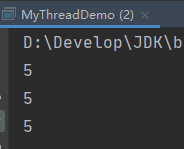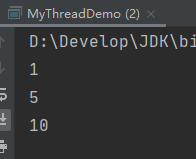
int getPriority() 返回此线程的优先级。
public class MyThreadDemo { public static void main(String[] args) { MyThread mt1 = new MyThread(); MyThread mt2 = new MyThread(); MyThread mt3 = new MyThread(); mt1.setName("飞机"); mt2.setName("高铁"); mt3.setName("汽车");
System.out.println(mt1.getPriority()); System.out.println(mt2.getPriority()); System.out.println(mt3.getPriority()); } }

运行结果可以得出,线程默认的优先级是:5
//void setPriority(int newPriority) 更改此线程的优先级。
把优先级设置成100时会发生异常:IllegalArgumentException,此异常 如果优先级不在MIN_PRIORITY到MAX_PRIORITY时会发生,所以此时来获取这两个值的范围是多少
public static void main(String[] args) { System.out.println(Thread.MIN_PRIORITY); System.out.println(Thread.NORM_PRIORITY); System.out.println(Thread.MAX_PRIORITY); }

最小值为:1 最大值为:10 默认值为:5
public class MyThreadDemo { public static void main(String[] args) { MyThread mt1 = new MyThread(); MyThread mt2 = new MyThread(); MyThread mt3 = new MyThread(); mt1.setName("飞机"); mt2.setName("高铁"); mt3.setName("汽车"); //void setPriority(int newPriority) 更改此线程的优先级。 mt1.setPriority(10); mt2.setPriority(5); mt3.setPriority(1); mt1.start(); mt2.start(); mt3.start(); } }
经过多次调用,可以看出优先级高的有较大几率会优先运行